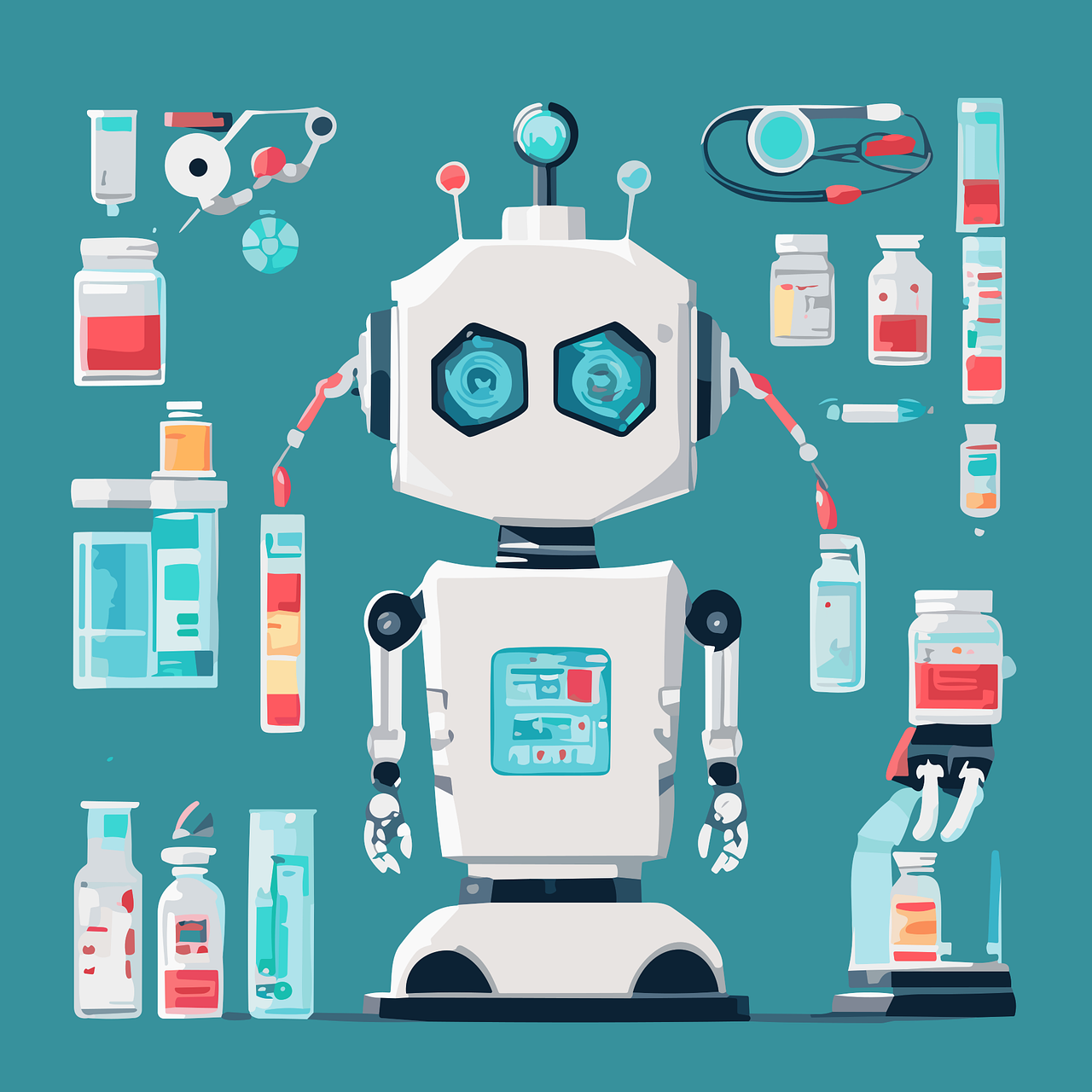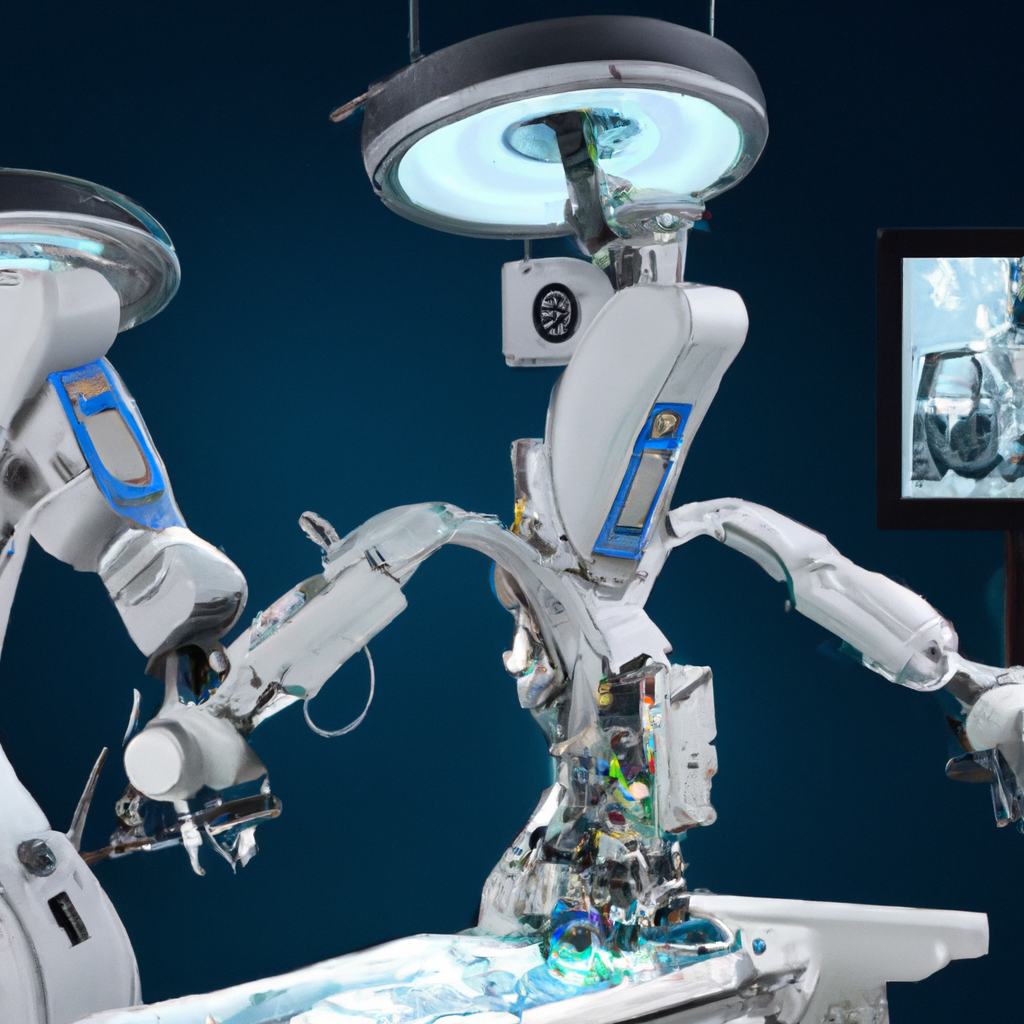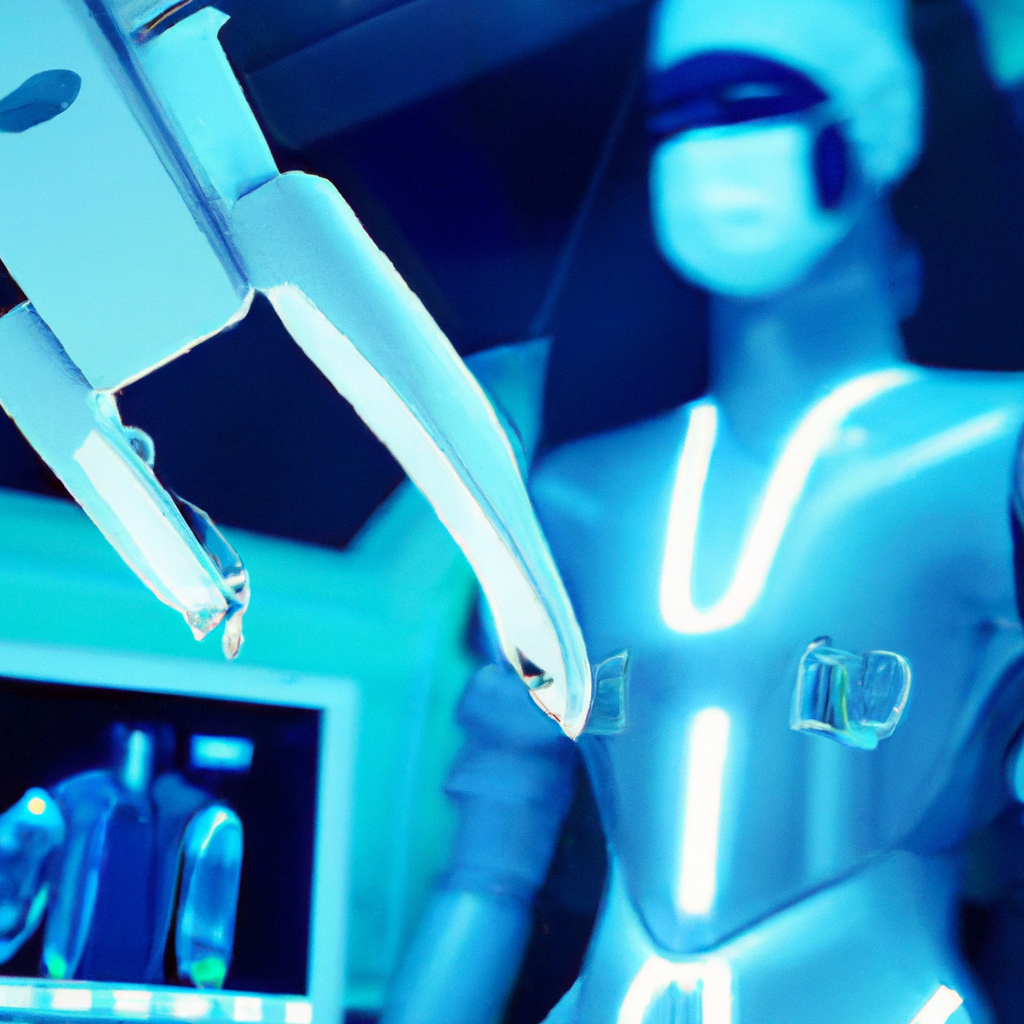Imagine a world where surgeries are no longer limited by human limitations, but instead empowered by the precision and capabilities of robots and artificial intelligence (AI). This groundbreaking article explores the incredible advancements in medical technology that are revolutionizing the field of surgery. From minimally invasive procedures to enhancing surgeon expertise, these robots and AI systems are transforming the way surgeries are performed, ultimately improving patient outcomes and shaping the future of healthcare. Discover how this innovative combination of man and machine is driving the evolution of surgery and opening up new possibilities for patients around the globe.

Understanding the Concept of Robotic Surgery
Definition of Robotic Surgery
Robotic surgery refers to the use of robotic systems to assist surgeons in performing complex surgical procedures with improved precision and control. Instead of directly manipulating surgical instruments, the surgeon operates the robotic system from a console, controlling the robot’s movements with the help of specialized hand controllers and foot pedals. The robotic system translates the surgeon’s motions into precise movements of the surgical instruments, allowing for greater maneuverability and dexterity during surgery.
How Robotic Surgery Works
Robotic surgery systems consist of three main components: the surgical console, robotic arms, and the patient-side cart. The surgeon sits at the console, which provides a high-definition, three-dimensional view of the surgical site. The surgeon’s hand movements are translated into precise motions by the robotic arms. These arms are equipped with specialized instruments that can rotate and bend far beyond what human hands are capable of. The patient-side cart holds the robotic arms and is positioned next to the patient during the surgery.
During the procedure, the surgeon guides the robotic arms to perform the necessary surgical tasks. The robotic system enhances the surgeon’s skills by offering improved visualization, tremor reduction, and greater range of motion. The system also includes advanced imaging technology, such as real-time ultrasound or computerized tomography (CT) scans, which assist the surgeon in making accurate decisions during surgery.
Different Robotic Surgery Systems
Several robotic surgery systems are available today, each offering unique features and capabilities. The most well-known system is the da Vinci Surgical System, developed by Intuitive Surgical. It is widely used in various surgical procedures, including cardiac, urologic, gynecologic, and general surgery. Other systems, such as the Medtronic’s Hugo™ Surgical System and Titan Medical’s SPORT™ Surgical System, are also gaining popularity in the field of robotic surgery. Each system has its own advantages and limitations, and surgeons choose the system that best suits their surgical needs.
The Role of Artificial Intelligence in Surgery
Introduction to AI in Healthcare
Artificial intelligence (AI) involves the development of computer systems that can perform tasks that typically require human intelligence, such as understanding natural language, recognizing patterns, and making decisions. In healthcare, AI has the potential to revolutionize various aspects of patient care, including surgery. AI algorithms can analyze vast amounts of medical data, identify patterns, and provide valuable insights to assist surgeons in making informed decisions.
AI Applications in Surgery
AI has numerous applications in surgery, ranging from preoperative planning to real-time intraoperative guidance and postoperative monitoring. In preoperative planning, AI algorithms can analyze medical images, such as CT scans or magnetic resonance imaging (MRI) scans, to assist surgeons in identifying optimal surgical approaches and predicting potential complications. During surgery, AI can provide real-time feedback to surgeons based on continuous analysis of data from various sensors and imaging systems. AI can also analyze postoperative data, such as patient outcomes and complications, to improve surgical techniques and outcomes.
Potential of AI in Surgical Operations
The integration of AI in surgical operations has the potential to improve surgical outcomes, increase efficiency, and reduce complications. AI algorithms can enhance the precision and accuracy of surgical procedures, reducing the risk of human error. By analyzing large datasets and identifying patterns, AI can help predict surgical complications and guide surgeons in making real-time decisions during complex surgical procedures. Moreover, AI has the ability to learn from the experiences of multiple surgeons, leading to a collective intelligence that can be shared across the medical community.
Past, Present, and Future Of Robotic Surgery and AI
Historical Overview of Robotic Surgery and AI
The concept of robotic surgery dates back to the 1980s, with the development of the PUMA 560, a robotic system designed for neurosurgical procedures. Since then, significant advancements have been made in robotic surgery technology. The introduction of the da Vinci Surgical System in the late 1990s marked a major milestone in the field, enabling surgeons to perform minimally invasive procedures with enhanced precision.
Similarly, the history of AI in healthcare can be traced back to the early days of medical computing. In the 1950s, researchers began exploring the potential of AI in medical diagnosis and decision-making. However, it is only in recent years that AI has gained significant traction in surgery and other healthcare domains, thanks to advancements in computational power, data availability, and machine learning algorithms.
Current Status of Robotic Surgery and AI
Currently, robotic surgery and AI are well-established technologies in the field of healthcare. Robotic surgery systems, such as the da Vinci Surgical System, have been widely adopted by surgeons around the world and are utilized in various surgical specialties. Likewise, AI applications in surgery, particularly in image analysis and decision support, are becoming increasingly prevalent. However, there is still room for improvement and further research to fully exploit the potential of these technologies.
Future Prospects of Robotic Surgery and AI
The future of robotic surgery and AI holds immense promise. Advancements in robotics and AI will continue to drive innovation in surgical techniques and patient care. We can expect to see further miniaturization of robotic systems, enabling minimally invasive procedures with even greater precision. Additionally, AI algorithms will become more sophisticated, integrating real-time data analysis, robotic guidance, and predictive modeling to assist surgeons in achieving optimal outcomes.
Benefits of Robotic Surgery and AI in Healthcare
Improved Surgical Precision
One of the key benefits of robotic surgery and AI is the enhanced precision they offer. Robotic systems can provide greater accuracy and stability, minimizing the risk of human error. Surgeons can manipulate robotic instruments with precision, allowing for precise incisions and suturing in delicate areas. Similarly, AI algorithms can analyze data in real-time, providing surgeons with valuable insights and helping them make precise decisions during surgery.
Reduced Surgical Risks
Robotic surgery and AI have the potential to reduce surgical risks and complications. The precise control offered by robotic systems can minimize tissue damage and blood loss, leading to faster recovery times and reduced postoperative pain. AI algorithms can analyze patient data, such as medical history and preoperative imaging, to identify potential risk factors and guide surgeons in minimizing complications during surgery. This can result in improved patient safety and reduced healthcare costs.
Better Patient Outcomes
By improving surgical precision and reducing surgical risks, robotic surgery and AI can ultimately lead to better patient outcomes. Patients undergoing robotic-assisted procedures often experience less pain, shorter hospital stays, and faster recovery times compared to traditional open surgery. Moreover, AI can facilitate personalized treatment plans by analyzing patient data and tailoring surgical approaches to individual needs. This individualized approach can optimize outcomes and improve overall patient satisfaction.
Advanced Data Analysis
The integration of AI in surgical procedures allows for advanced data analysis on a scale that is not feasible for humans alone. AI algorithms can process large amounts of patient data, including medical records, imaging scans, and surgical outcomes, to identify patterns, predict outcomes, and improve surgical techniques. This data-driven approach has the potential to revolutionize surgical research and enable evidence-based decision-making in real-time.

Challenges and Limitations of Robotic Surgery and AI
Technical Challenges
Robotic surgery and AI face several technical challenges that need to be addressed for widespread adoption. Robotic systems require specialized training and infrastructure, and not all hospitals and clinics have access to these resources. Additionally, connectivity and interoperability issues between different AI algorithms and robotic systems can hinder seamless integration. Overcoming these technical challenges will require collaboration between industry stakeholders, healthcare providers, and regulatory bodies.
Regulatory and Ethical Issues
The implementation of robotic surgery and AI in healthcare raises regulatory and ethical concerns. As the technology evolves, regulatory frameworks need to keep pace to ensure patient safety and quality of care. Ethical considerations, such as privacy and informed consent, also need to be addressed to safeguard patient rights. Ensuring transparency and accountability in the development, use, and oversight of these technologies is crucial to build trust among healthcare professionals and the general public.
Concerns about Responsibility and Accountability
Robotic surgery and AI raise questions about responsibility and accountability in surgical procedures. As robotic systems and AI algorithms play a more active role in surgical decision-making and execution, questions arise regarding who should be held responsible in case of adverse events or complications. Clear guidelines and protocols need to be established to define the roles and responsibilities of surgeons, robotic systems, and AI algorithms, ensuring appropriate accountability and reducing legal uncertainties.
Cost Implications
The implementation of robotic surgery and AI comes with significant cost implications. Robotic systems are expensive to acquire and maintain, requiring substantial upfront investments. AI applications may also require specialized hardware and software, adding to the overall cost. While the initial investment can be substantial, studies have shown that the long-term benefits, such as reduced hospital stays and improved patient outcomes, may outweigh the costs. However, cost-effectiveness studies and innovative reimbursement models are needed to ensure equitable access to these technologies.
Case Studies of Successful Robotic Surgery and AI Implementations
Case Study 1: The Da Vinci Surgical System
The da Vinci Surgical System is one of the most extensively studied and widely adopted robotic surgery systems. Numerous clinical studies have demonstrated its effectiveness in various surgical specialties, such as urology, gynecology, and cardiothoracic surgery. The system’s robotic arms and advanced visualization capabilities enable surgeons to perform complex procedures with improved precision and reduced complications. Patient outcomes, such as reduced blood loss and shorter hospital stays, have been consistently observed in studies using the da Vinci Surgical System.
Case Study 2: The Mako Robotic-Arm Assisted Surgery
The Mako Robotic-Arm Assisted Surgery system is used in orthopedic procedures, particularly in joint replacements. The system combines a robotic arm with a real-time 3D imaging system to create a virtual model of the patient’s anatomy. Surgeons use this model to plan and execute the surgery with enhanced precision and accuracy. Clinical studies have shown that the Mako system can improve implant alignment, reduce complications, and result in better patient outcomes compared to traditional manual techniques.
Case Study 3: AI in Predicting Surgical Complications
AI algorithms have been applied to predict surgical complications and identify high-risk patients. Researchers have developed machine learning models that can analyze patient data, such as medical history, preoperative imaging, and laboratory results, to predict the likelihood of postoperative complications. These models have demonstrated promising accuracy and can provide surgeons with valuable information to guide their decision-making and optimize patient care. Early identification of complications can improve clinical outcomes and help healthcare providers allocate resources more efficiently.

Educating Medical Practitioners on Robotic Surgery and AI
Current State of Professional Education on the Subject
Professional education on robotic surgery and AI is essential to ensure the successful integration of these technologies into clinical practice. Many medical schools and surgical training programs have recognized the importance of including robotic surgery and AI in their curriculum. Specialized training programs and courses are available to provide surgeons and healthcare professionals with the necessary knowledge and skills to utilize these technologies effectively. However, there is still a need to standardize and expand educational opportunities to reach a broader audience.
The Importance of Continued Education and Training
Continued education and training are crucial in keeping up with the advancements in robotic surgery and AI. As technology evolves, surgeons and healthcare professionals need to stay up to date with the latest developments and best practices. This includes attending conferences, workshops, and hands-on training sessions. Continued education ensures that surgeons are competent in using robotic systems and AI algorithms, maximizing the benefits of these technologies while minimizing potential risks.
Ways to Integrate Robotic and AI Knowledge into Medical Curriculums
To promote the integration of robotic surgery and AI knowledge into medical curriculums, various approaches can be adopted. Medical schools and training programs can establish dedicated courses and modules on robotics and AI, covering both theoretical and practical aspects. Collaborations between academia and industry can facilitate the implementation of hands-on training programs, allowing students to gain exposure to robotic systems and AI algorithms. Additionally, incorporating robotic surgery and AI into surgical residency programs can ensure comprehensive training for future surgeons.
Economic Impact of Robotic Surgery and AI
Financial Benefits to Hospitals and Clinics
Robotic surgery and AI have the potential to generate financial benefits for hospitals and clinics. While the initial investment in robotic systems and AI infrastructure can be significant, these technologies can lead to cost savings in the long run. Reduced surgical complications and hospital stays translate into lower healthcare costs. Moreover, shorter recovery times and improved patient outcomes can attract more patients, increasing the revenue potential for healthcare providers.
Impact on Healthcare Costs
The impact of robotic surgery and AI on healthcare costs is a subject of debate. While the initial investment and maintenance costs of robotic systems and AI infrastructure can be high, studies have shown that these technologies can yield long-term cost savings. Reduced hospital stays, decreased complication rates, and improved patient outcomes contribute to lower healthcare costs. However, cost-effectiveness analyses are still needed to provide concrete evidence of the economic benefits and weigh them against the initial investment.
Economic Investment Required for Robotic Surgery and AI
The economic investment required for the implementation of robotic surgery and AI depends on various factors, including the choice of technology, training and education programs, and infrastructure needs. Robotic systems, such as the da Vinci Surgical System, can cost several million dollars, including the cost of installation, maintenance, and disposables. AI infrastructure, including hardware and software, can also require significant investment. Healthcare organizations need to carefully assess the potential benefits and costs and develop financial strategies to ensure sustainable implementation of these technologies.
Public Reception and Perception of Robotic Surgery and AI
General Public’s Attitude Towards Robotic Surgery
The general public’s attitude towards robotic surgery has been generally positive. The idea of robotic assistance in surgery is viewed as a technological advancement that can improve patient outcomes and enhance surgical precision. Robotic surgery is often seen as less invasive and associated with faster recovery times. However, public understanding of the technology can vary, and misconceptions and concerns may arise due to inaccurate or exaggerated media portrayals. Promoting accurate information and patient education can help shape a realistic and informed perception.
Concerns and Skepticism
While there is overall optimism about the potential benefits of robotic surgery and AI, concerns and skepticism exist. Some individuals may worry about the safety and reliability of robotic systems, fearing a loss of human control during surgery. Others may be skeptical about the cost-effectiveness and accessibility of these technologies. Addressing these concerns requires open and transparent communication, providing information on the extensive training and safety measures in place, as well as the potential long-term benefits.
Increasing Awareness and Understanding
Increased awareness and understanding of robotic surgery and AI are vital to foster acceptance and trust among the public. Educating the general public about the capabilities and limitations of these technologies can help dispel misconceptions and build confidence. This can be achieved through various channels, including public lectures, educational materials, and media outreach. Transparency in clinical outcomes and sharing success stories can also contribute to a better understanding of the benefits that robotic surgery and AI can bring to patient care.
International Development and Diversity in Robotic Surgery and AI
Leading Countries in Robotic Surgery
Robotic surgery has gained significant traction worldwide, with several countries at the forefront of its development and adoption. The United States, owing to its early involvement and innovation in the field, has seen widespread adoption of robotic surgery systems in various healthcare settings. European countries, including Germany and France, have also made significant contributions to the advancement of robotic surgery technology. Moreover, countries like Japan, South Korea, and China have extensively utilized robotic surgery systems, particularly in urologic and gynecologic procedures.
Differences in Adoption Rates Worldwide
Despite the global advancements in robotic surgery, there are differences in adoption rates across countries. Factors such as regulatory frameworks, healthcare infrastructure, training programs, and financial resources influence the adoption and integration of robotic surgery systems. Economic constraints and access to technology can also contribute to variations in adoption rates. Efforts are being made at both the national and international levels to bridge these gaps and create opportunities for knowledge exchange and collaboration.
Global Efforts to Improve and Promote Robotic Surgery and AI
Global initiatives are underway to improve and promote robotic surgery and AI. Collaborative efforts between healthcare organizations, research institutions, and industry stakeholders aim to accelerate the development and adoption of these technologies. International conferences and professional networks facilitate knowledge sharing and collaborative research. Additionally, organizations such as the International Society of Robotic Surgery and the World Robotics Society promote guidelines and best practices to ensure standardization and quality in the field of robotic surgery and AI.
In conclusion, robotic surgery and AI have revolutionized the field of healthcare, significantly enhancing surgical precision, reducing risks, improving patient outcomes, and enabling advanced data analysis. However, challenges and limitations exist, such as technical constraints, regulatory and ethical concerns, issues of responsibility and accountability, and cost implications. Case studies of successful robotic surgery and AI implementations demonstrate the potential of these technologies. Educating medical practitioners and integrating knowledge into medical curriculums is crucial for their effective use. The economic impact of robotic surgery and AI can be significant, with financial benefits and potential cost savings for healthcare providers. Public reception and perception of these technologies require accurate information and increased awareness. International development and diversity in robotic surgery and AI are being promoted through collaboration and knowledge exchange. With continued advancements and collaborative efforts, the future prospects for robotic surgery and AI in healthcare are promising indeed.










